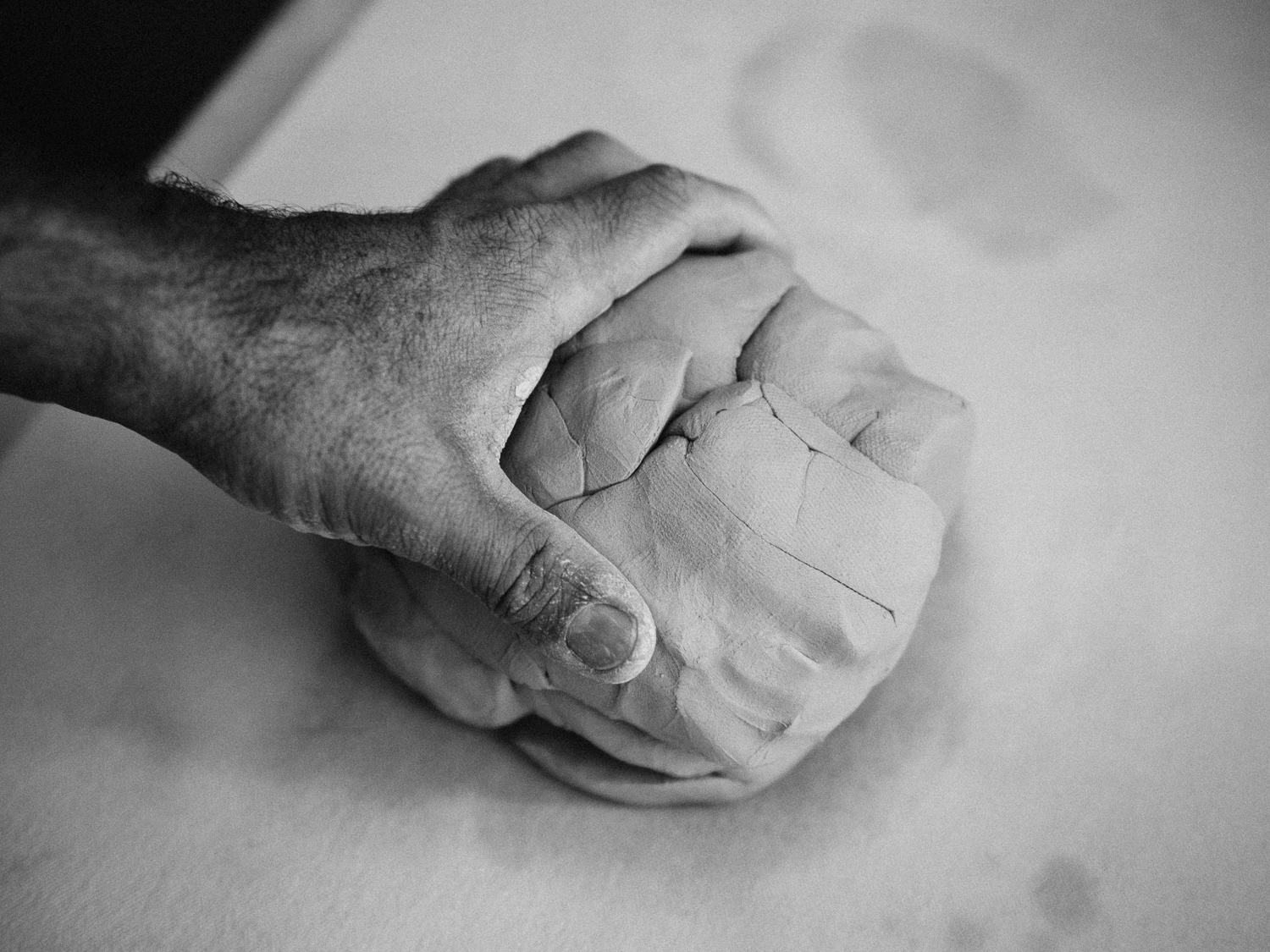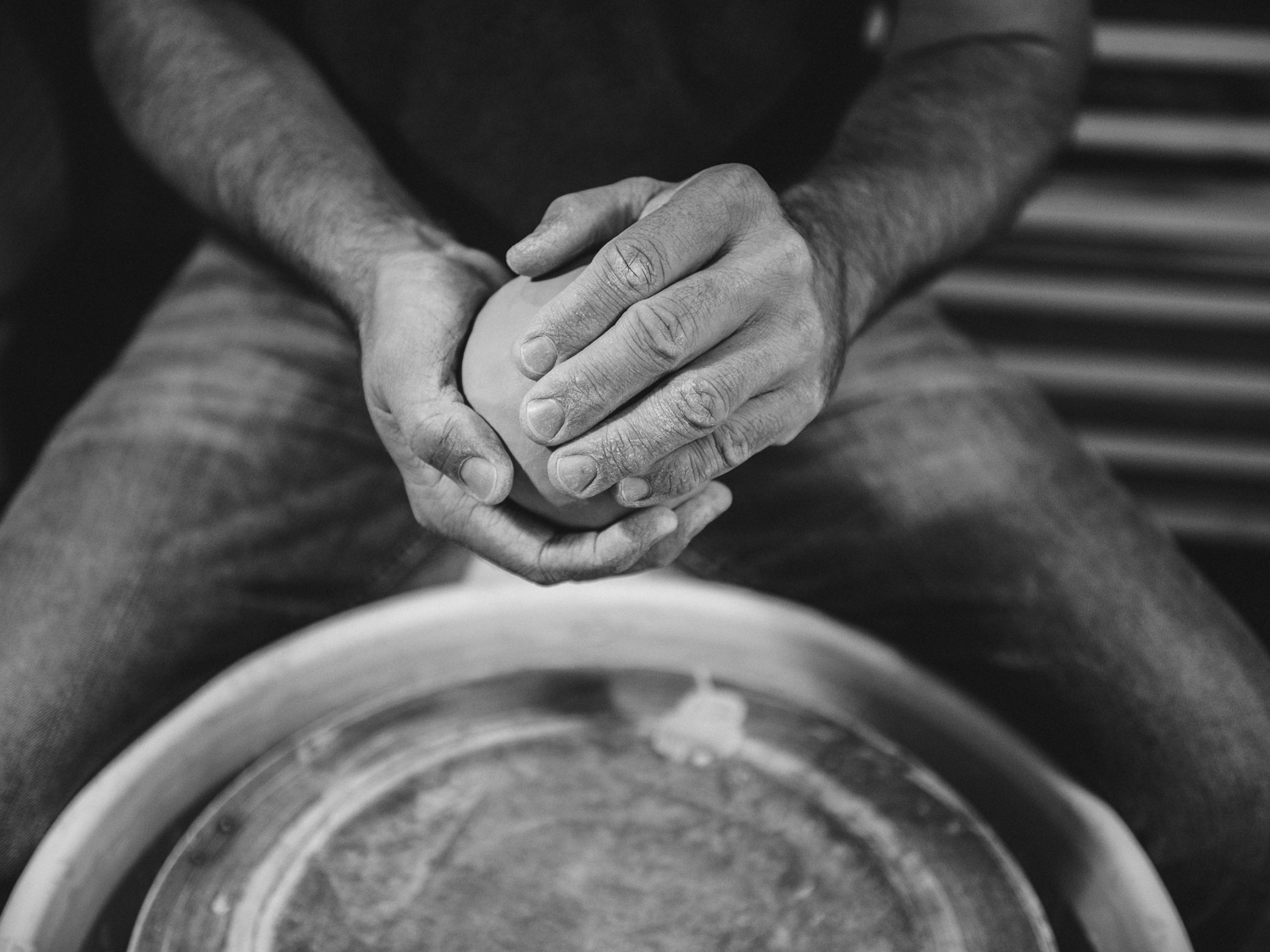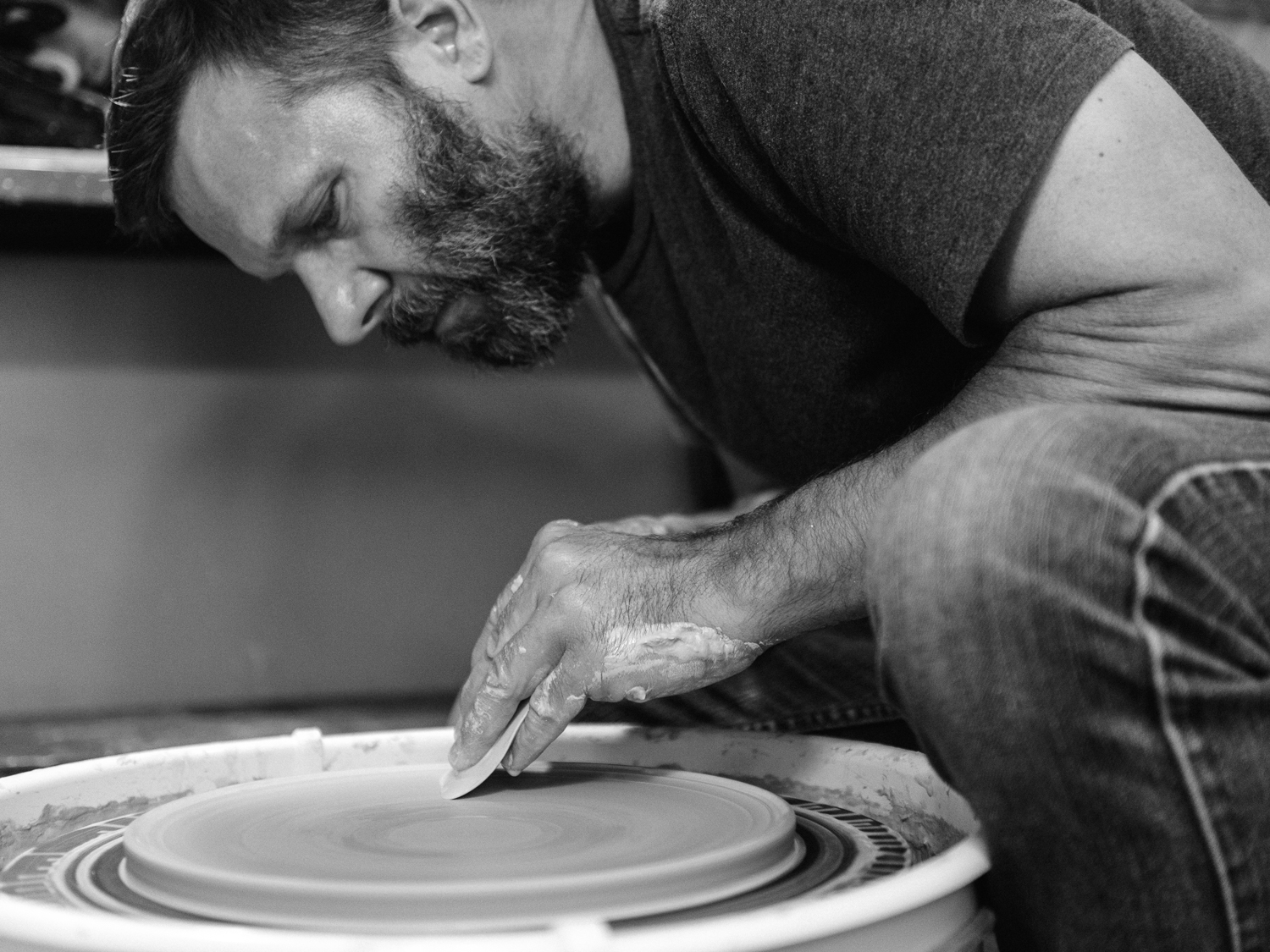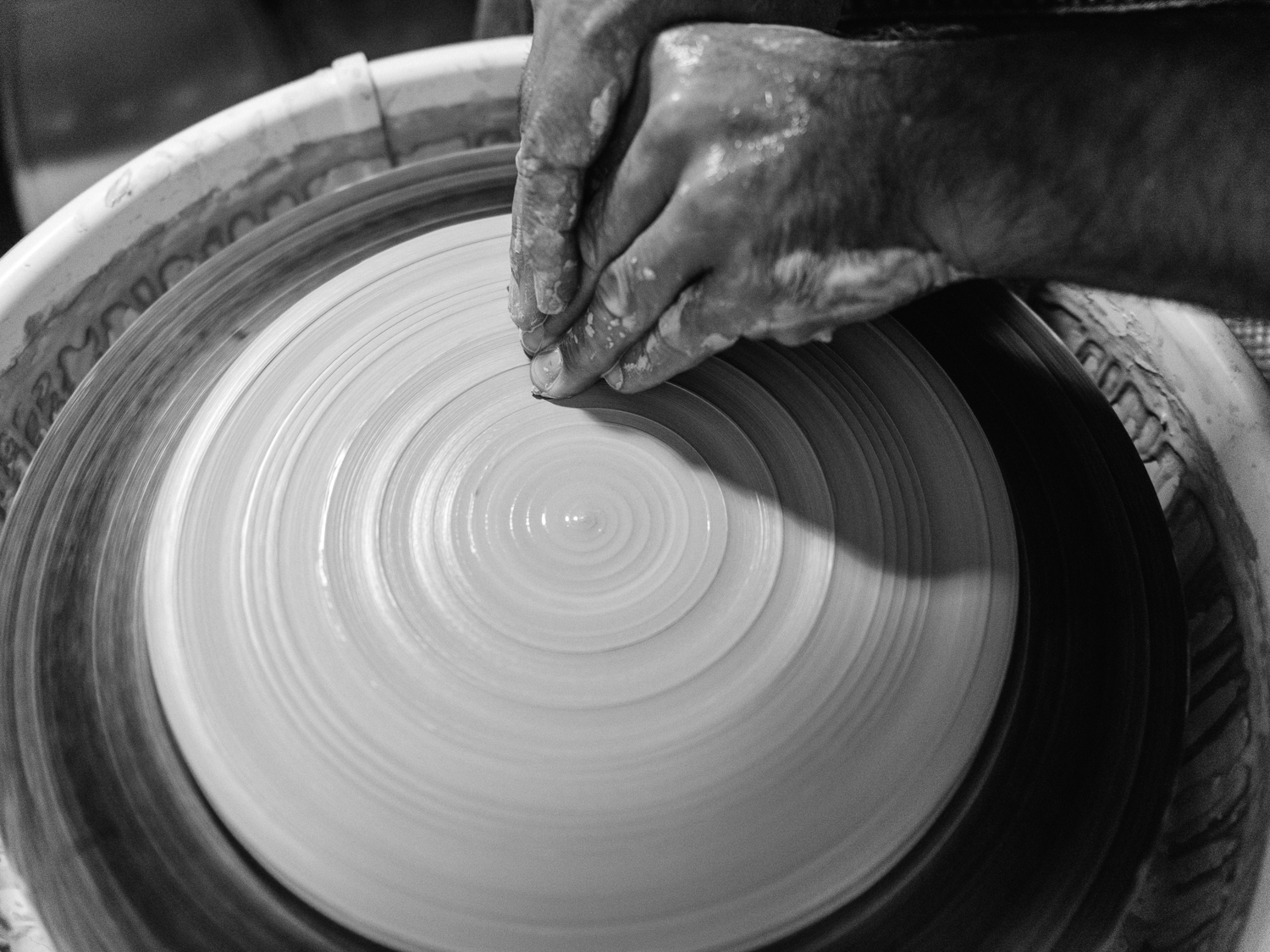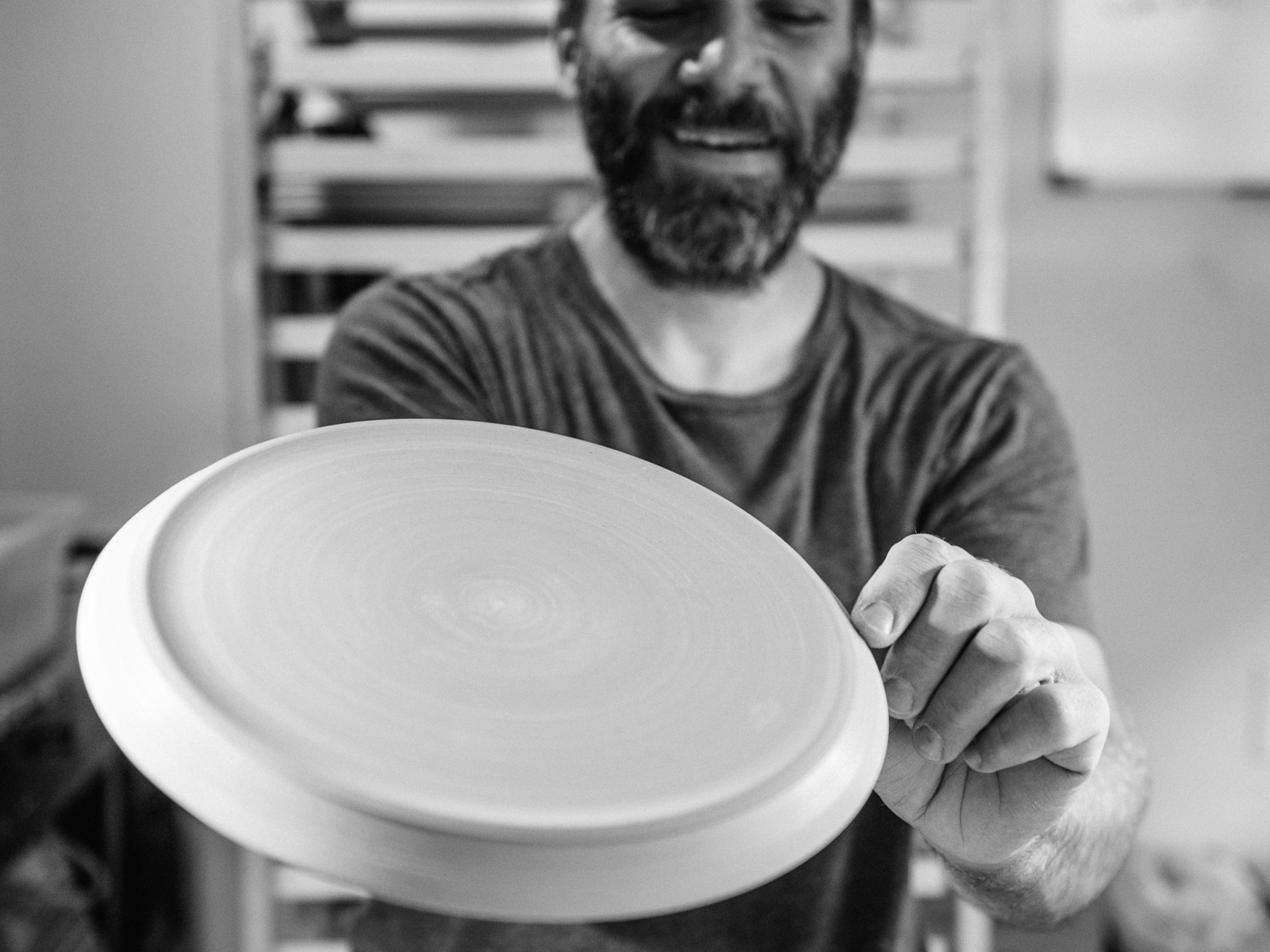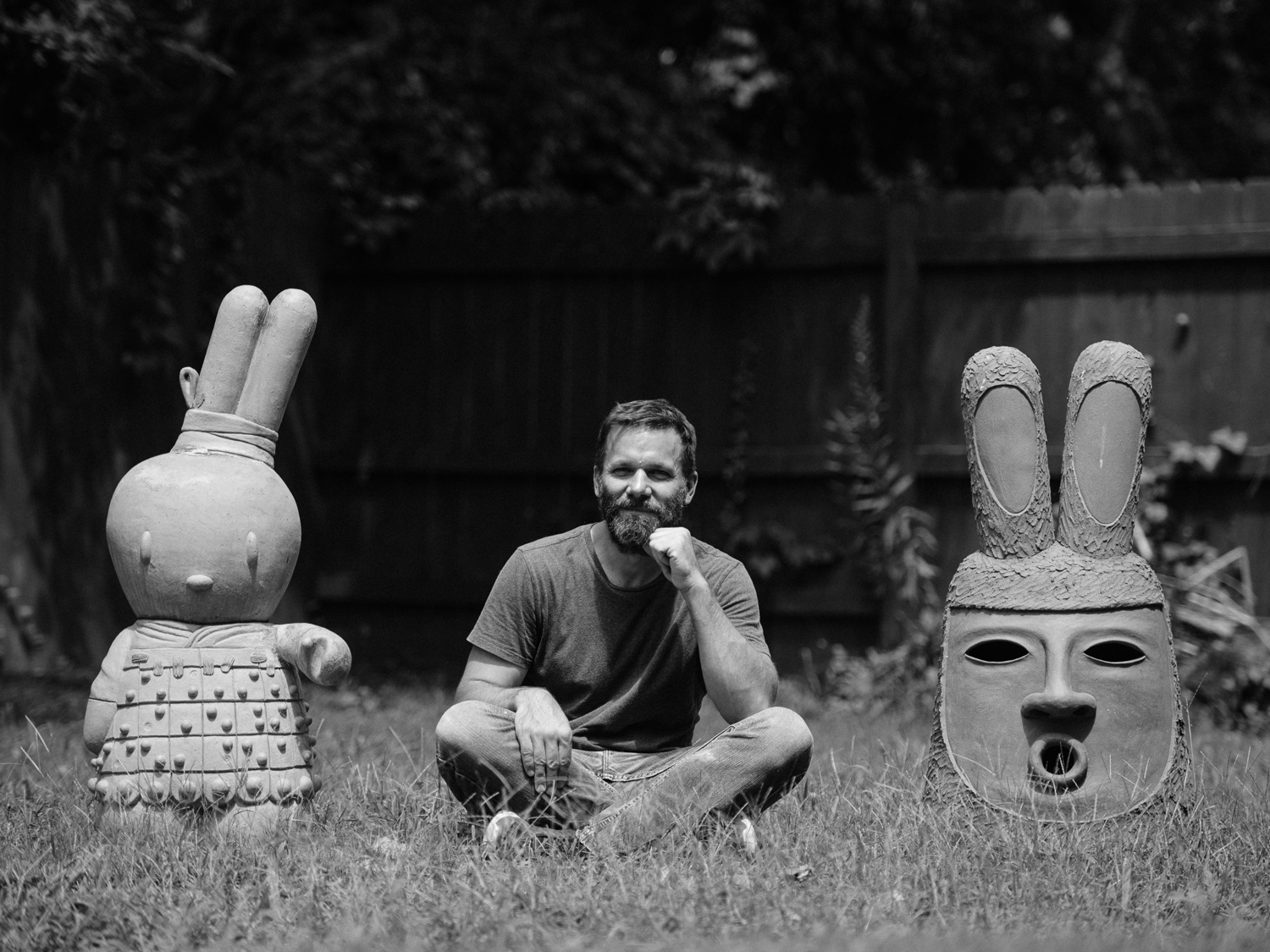John Donovan, Artist & Owner of Tenure Ceramics
John Donovan in his home studio in Cleveland Park. All photos by Yve Assad.
A lot of people believe that Southern hospitality is what sets Nashvillians apart from people in other cities. While we are a rather welcoming folk, I don't think politesse is the most unique trait of those in my adopted hometown.
The special sauce that makes Nashville such an interesting place to live and work is the willingness of our creative class to cooperate to make great things happen. Indeed, few of those who find big success in our city’s creative sphere get there alone. It’s all about collaboration.
Nashville chefs actively seek out ways to work with area musicians who enjoy collaborating with our visual and performing artists who look for opportunities to partner with local fashion designers. This kind of interdisciplinary cooperation allows creative types to develop concepts and problem-solve in innovative ways that they might not have been able to achieve going it alone.
One of my favorite examples of this interdependence involves my friend John Donovan, a respected local artist who works in ceramic sculpture. John was teaching college in 2007 when chef Tandy Wilson challenged him to use his talent in a new and more commercial way, asking John to design commercial-grade serving pieces to be used in his new restaurant, City House. At the time, John’s wife Lisa was the resident pastry chef, making the collab a real family affair.
Nine years later, the pieces John made for Tandy are still in circulation at City House, and John has expanded his custom pottery roster to include commissions from chef Josh Habiger at the Wedgewood-Houston food mecca Bastion and Miranda Whitcomb Pontes’ hotly-anticipated Germantown restaurant Geist House. John works closely with his restauranteur clients to develop signature shapes and styles of pottery, as well as distinctive colors and glazes to match the sensibility of the space and personality of the owner. (Sniffing around his studio a few months ago, I remarked on the cool and sexy black finish on a collection of bowls and was told it was “Miranda’s glaze” — a beautiful case of art imitating life.)
Last year, based on the success of his restaurant collaborations and feedback he received from key players in the national food community, John launched Tenure Ceramics, a company that makes his tableware available to the public. His side gig’s name is a tongue-in-cheek nod to his professional status at Middle Tennessee State University, where he’s a professor in the art department.
John currently works out of a small studio shed behind the Cleveland Park home he shares with Lisa and their two kids, Joseph and Maggie. There, he designs the figurative ceramic fine art that he’s exhibited at Nashville’s Zeitgeist and LeMieux Galleries in New Orleans and completes orders made through Tenure’s retail website, which launched earlier this summer.
A few weeks ago, John and I met up at my house for his TCR interview. During our chat, he talked about the birth of Tenure, balancing dual careers in commercial and fine arts, and his deep background in ceramics, which began under the watchful eye of a wonderfully eccentric mentor in his hometown of Pensacola, Florida, when John was in fourth grade. Enjoy.
TCR: We could've done this at a coffee shop, but I find folks open up more when we meet at my house.
JOHN: And I'm already over-stimulated. Like, I have focus, but it's hard. One of the things that's nice about how small my work space is now is that I have no choice but to focus, because when I'm working, there's only enough room for exactly what I'm doing.
TCR: How big is your home studio?
JOHN: It’s about 300 square feet. The kilns are in the shed out back. Because the space is so small, I'll make 40 plates for a restaurant and then I have to stop. Sometimes it works: once I reach capacity, I can put the plates in the kiln and then switch to making stuff for the New Orleans show, which will happen in September of 2017. It’s a collaboration with Mark Hosford, who’s a print-making professor at Vanderbilt. And then whenever the plates are ready to come out, the (New Orleans pieces) inside can rotate in. It's like you're juggling and you can't drop a ball because there's nowhere to put it. It creates a kind of buzz. If you can find a rhythm, it's this wonderful kind of self-sustaining practice, where you make, you trim, you fire; you make, you trim, you fire.
TCR: Has Tenure and the projects you do for restaurants changed the way you work on your sculpture?
JOHN: It demands that I'm working more, physically, in the studio. There's not this waiting for the moment of creative genius that comes with the sculpture. With sculptural work, I always worked in these really interrupted bursts. Like, I’m really busy and then nothing.
I see the pottery being a nice alternative to that. It's steady work, but the gears are still turning. When I'm sitting there making 24 plates, I'm not thinking about the plates, and there’s a repetition that’s more like calisthenics. You’re doing this same movement over and over again. I hesitate to use the word meditative, but there is this meditative repetition to the process. And when you get into that rhythm, other parts of your brain kick in. That's when the neurons start firing.
TCR: I love getting to that place when I’m working. It’s so dreamy when everything else drops away and your mind can wander to really cool places.
JOHN: My fear going into making pottery for restaurants was that I’d be surrendering the sculptural side of what I do. But it’s not. The cylinders are actually firing better. This is a nice surprise, because I went into this knowing that I've enjoyed a busy career as a studio artist. I've enjoyed showing in New Orleans since 1998. I've enjoyed showing at Zeitgeist in Nashville since 2005 or '06. I've enjoyed putting a show together for the Huntsville Museum of Art in Alabama. I like all that stuff.
But when I started saying yes to some of these larger commissions for restaurants, I decided to stop making sculpture for a while and just do the pottery. That was the plan, though it isn't what's happened. The sculpture has remained in a much more organic way as opposed to more of a rote way.
TCR: That's interesting. I have another artist friend who is dealing with the same thing right now, in terms of balancing fine art with commercial work. She’s really torn between being an artist -
JOHN: Or a craftsperson.
TCR: Yes. In her case, there’s fine art and then there’s the commerce that grows out of its commodification. How do you nurture both without compromising either? It's hard.
JOHN: It is. I think something that helped me a lot was when Heidi Ross gave me the name - Tenure. At first I was like, oh that’s hilarious. But it creates a really bright line of distinction. And that created a lot of freedom. It was really smart.
Heidi was really important in that step. For a while, this business was a very nebulous little fragile soap bubble that could have popped at any minute, had I been in a different community at the time, had I not had the people from the outside making suggestions on how I might move forward, this might have been a different story. Tenure exceeds what I can do on my own, so it is by design collaborative.
TCR: I know Lisa has been an integral part of your support staff. What was her place in Tenure’s evolution?
JOHN: For years, Lisa was going to her food events and festivals in different cities and people would say, “I've heard your husband works with clay…” And, in a very subtle and not heavy-handed kind of way, she kept a list of who was asking.
Every once in a while she would plant a seed about me starting to make tableware, and I'd tell her I was too busy. But she knows how I work. She knows that if she’d been like, “You've got to do this,” I would've panicked and run off into the woods, never to be seen again. But if she just kept track of how many people were interested in the work that I'd eventually come around. That gradual groundswell of interest and the willingness of people to take a chance on me allowed it to happen.
TCR: You went to school for fine art. How did that kind of education prepare you for this dual career you have now?
JOHN: I was really lucky. My parents worked really hard to send me to a great BFA program in New Orleans, and I had an amazing rapport with my faculty. They instilled in me a respect for the creative process. And that instilled in me a respect for the ability to be moderately creative but to work really hard and have a great product — and a great career.
The faculty was very career-minded, and the students were like-minded. I’d look around the room during BFA critiques and be like, holy shit, there's a bunch of creative ninjas in this room. There have been a few times in my career when that's happened — when I look around me and think why am I here? And in those situations you realize everyone else is thinking the same thing. And that’s when you know you had better do some really good work.
At school, I loved the critique process. In undergrad critiques, it wasn't to make each other feel good about their work. It was to remind each other what you're good at, point out what you're bad at, but then leave the room with a list of ways you might address that. People would cry, people would feel like they were personally insulted, but the goal was to get better. Same thing in grad school.
And after I graduated, that was gone — the honest dialogue about work. At school, there's this sequestered board of creative consultants. And then you get out and all anybody tells you is that what you’re doing looks great. And you know they're lying. After school, it’s hard to find that source of creative push or collaboration.
TCR: Where did you end up finding it?
JOHN: On the job. One of my favorite experiences has been working for Bastion. Whenever I made something for Josh and it wasn't what he wanted, he’d come in and say, "That's not it.” There is a moment of sting when you're like, I failed. But then —
TCR: It turns into an opportunity.
JOHN: Yes. There's something really nice about a tangible hit or miss. Whenever I'm making sculpture for a show, I don't know if it's right or not. When I'm making dinnerware for a restaurant, and it’s what they want, there’s a check in the box. That's something I really like about the new species of work. And Josh has no problem telling me yes, no, yes.
TCR: He’s very exacting – that’s his reputation.
JOHN: During this process, he was time traveling into the future to when his food would be on the plates. He knew what he wanted it to look like as it was happening.
TCR: How did you discover clay and sculpture?
JOHN: Again, I talk about the serendipity of the right people being around me at the right time.
I went to Catholic school – parochial school. I was a bad kid, disruptive. I would cuss in front of a nun just to have her hit me with a ruler, you know? I was a little shit.
I had a really good math teacher in fourth grade. She recognized that I acted out just to act out. Math was always my worst subject, so I’d rush through it. And as soon as I’d finish my math quizzes, I'd be kicking the kid's desk next to me until I got in trouble. So my teacher asked me if I wanted to draw instead. And I loved to draw.
I would draw constantly at home. My dad had an engineering firm and he would bring home big 24-by-36 inch pieces of paper and put them on the desk in my room. I’d fill those things up with little dinosaurs and dragons and monsters and knights and army men and whatever.
So my teacher figured out that if I was drawing, I wasn’t kicking my neighbor. So she told me that even if I’d done a terrible job on my quiz, to just flip my page and start drawing. And I quit being a jerk in that class. And she told my parents that if I had a creative outlet, I’d stop being a jerk at other times.
And my mom, thank god, she was a recovering hippie. There was this potter she knew named Peter King. To this day, he runs an architectural ceramics firm out of Pensacola named Stonehaus Ceramics. This was the first place I met clay.
Peter has a beautiful studio. You felt like you were walking into a Costa Rican rainforest. He had these huge palm trees that he started in big pots that he made and then moved into the ground. As you walk in, it's this concrete pathway with all this terra cotta tile work, custom made right there.
My mom took me to his studio one afternoon, told him what my teacher said, and asked if I could come there after school and hang out until dinner. And he said yes.
So she leaves, and he's like, waving to her and saying, “Bye Susie! Come back and get him at five.” And then he swoops down on me. “There are some rules here” — because he knew I was a little shit. “You don't come here to screw around. You can come here and make anything you want. But you do not break anything of mine.” I was nine years old and I was like yep, I'll do it.
From fourth grade on, during the school year, after school, at least three out of five days, I was there. By the time I got to eighth grade, instead of just drawing little dinosaurs and robots and monsters, I was making them with clay. So instead of painting Godzilla tearing down a city, I’d make a little clay city and clay Godzilla breaking down half the buildings, with, you know, cotton balls for smoke. So there were these little narrative vignettes that I started to make in three dimensions instead of two.
TCR: You had yourself a little 3D dream factory.
JOHN: It was a special place for me that I wanted to protect.
Peter looked like a stereotypical Jesus. I mean, great hair, great little beard. He was a marathon runner at that point, so he was real skinny. He’d wear his little running shorts to the studio. He was a bigger than life character.
Everyone called him a crazy longhaired hippie. And I was like, don’t be disparaging. This man is a goddamn genius! I was really lucky that at a very early age I got to meet the medium on a really intense scale through Peter.
When you have good mentors, you hear their voice when you're approaching dangerous territory with your art. I'll hear Peter's voice when I'm under-ambitious. Because he’s like, “Go big.” You know? And then when I get sloppy, I'll hear my graduate school professor Pierro's voice, because he’s a very precise craftsman: “Slow down, idiot.” And when I get repetitive or my content gets trite, I hear my undergraduate professor Steve saying, “You've got something more to say than that.”
TCR: You’ve had some pretty powerful professional role models.
JOHN: I think it's been easy because they were just so good at what they did. There was never an embracing of even a molecule of mediocrity, to their detriment sometimes. Peter would flush three weeks of work on a job if it wasn't where he wanted it to be.
TCR: I read an interview with a major fashion magazine editor recently and she said that her job was to eliminate the average — that as an editor, mediocrity cannot exist in your world. Everything you publish must be exquisite and amazing. That really inspired me for some reason.
JOHN: It becomes a slippery slope. I mean do I move the slider I use to measure quality down a little because of the volume of a project? I don't like to think that I would.
What I do have to admit to myself is that there are times when the neurons that are usually reserved for the sculpture fire during the making of the pottery. It’s really fun when those parts of my brain get activated. I find that I think about a place setting in the way that I would a sculptural object. Or contrasting textures or colors. Or how this guy (a piece of pottery) is going to look when he fits inside of this guy or that guy.
TCR: The bottom line is you can't stop being an artist even if you're producing something for commercial use.
JOHN: Right — it's all your work. And I think that's important. I mean, it's another brand’s name on it, but it's still mine. And I don't want to be associated with something that I feel is questionably designed. I want the ergonomics of a piece to compel someone to pick it up. Like some of my bowls have little divots and places of compression. They just want you to shake hands with them. It's almost like a rock climbing wall handhold.
At Bastion, there's a sort of conference call going on, where the food has been thoughtfully made. The pottery's been thoughtfully made. The diner is picking up the bowl and shaking hands with the maker of the bowl and the maker of the food at the same time. It’s an active engagement. And for me, that's collaboration.
You can do that with color, too. There was some type of sauce that Tandy was making at City House that was really bright orange, so he wanted to go with turquoise pottery. And when that orange sauce hit the turquoise, it was like wow! It wakes it up. It's purposeful, thoughtful design.
TCR: It's also food as art, which I think is really interesting as a concept.
JOHN: I actually think of what I'm doing as making canvases for chefs to paint on. The plate is there but the work's not done until the food hits it.
I took Maggie to the friends-and-family opening dinner at Bastion. One dish that came out was duck, and the way that Josh constructed it, the way that he laminated each slice… Like, he hydrostatically bonded each slice of duck to the next with a sauce. It was beautiful.
We were looking at the duck in front of us and Maggie said to me, “I don't want to break it.” So thinking about it that way, the work’s not even done when the food hits the plate; it's done when the diner makes the decision to engage. They are part of the experience. And then it's performance art.
Yve Assad is a photographer based in Nashville, but her home is mainly on the road, specifically on the back of a motorcycle. A seeker of beautiful landscapes, she shoots on the ground and in the air. She also has a passion for two wheels, and has been documenting motorcycle culture for the past decade. Her travels have taken her all over the United States and as far as India. In 2014, she completed a 5000-mile solo journey to Nova Scotia on the 1976 BMW R90/6 her husband gave her as an engagement ring. Enjoy her photography at www.yvephoto.com.


